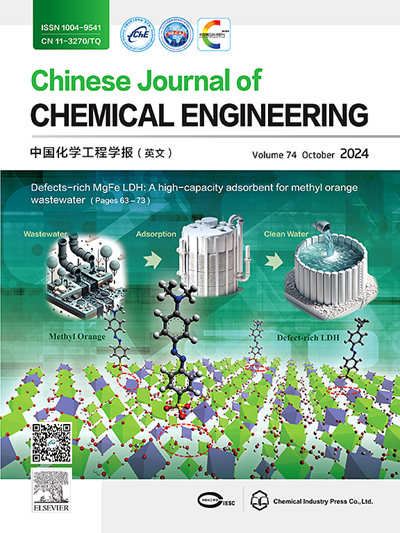Facile synthesis copper-modified titania (Cu/TiO2) nanoparticles for high-efficiency Congo red adsorption
IF 3.7
3区 工程技术
Q2 ENGINEERING, CHEMICAL
引用次数: 0
Abstract
Pure TiO2 and copper-modified titania (Cu/TiO2) nanoparticles were synthesized through sol gel combined with the pyrolysis method for the removal of Congo red (CR) in wastewater treatment. Surface morphology and structural evaluation utilized XRD, TEM, Raman, FTIR and BET techniques. Cu/TiO2 showed rich defects and a higher specific surface area than that of TiO2. The 1Cu/TiO2 (molar ratio Cu/TiO2 of 1/100) showed the best performance to adsorption of CR solution at different reaction conditions (contact duration, CR concentration, adsorbent dose, temperature, and initial pH). Adsorption kinetics and equilibrium isotherms were well-described with a pseudo-second-order kinetics and Freundlich model, respectively. The negative ΔG indicates stable adsorption of CR on the Cu/TiO2 surface. The adsorption efficiency only decreases by 6% after 5 cycles of adsorption regeneration. The successful synthesis of Cu/TiO2 offers a new possibility to address the problems related to CR dye from aqueous solutions.

制备高效吸附刚果红的铜修饰二氧化钛纳米粒子
采用溶胶-凝胶结合热解法合成了纯TiO2和铜修饰二氧化钛(Cu/TiO2)纳米颗粒,用于废水处理中的刚果红(CR)脱除。利用XRD, TEM, Raman, FTIR和BET技术对其表面形貌和结构进行了评价。Cu/TiO2具有丰富的缺陷,比表面积高于TiO2。不同反应条件(接触时间、CR浓度、吸附剂剂量、温度和初始pH)下,1Cu/TiO2 (Cu/TiO2摩尔比为1/100)对CR溶液的吸附性能最好。吸附动力学和平衡等温线分别用拟二级动力学和Freundlich模型描述得很好。负ΔG表示CR在Cu/TiO2表面吸附稳定。经过5次循环吸附再生后,吸附效率仅下降6%。Cu/TiO2的成功合成为解决水溶液中CR染料的相关问题提供了新的可能性。
本文章由计算机程序翻译,如有差异,请以英文原文为准。
求助全文
约1分钟内获得全文
求助全文
来源期刊

Chinese Journal of Chemical Engineering
工程技术-工程:化工
CiteScore
6.60
自引率
5.30%
发文量
4309
审稿时长
31 days
期刊介绍:
The Chinese Journal of Chemical Engineering (Monthly, started in 1982) is the official journal of the Chemical Industry and Engineering Society of China and published by the Chemical Industry Press Co. Ltd. The aim of the journal is to develop the international exchange of scientific and technical information in the field of chemical engineering. It publishes original research papers that cover the major advancements and achievements in chemical engineering in China as well as some articles from overseas contributors.
The topics of journal include chemical engineering, chemical technology, biochemical engineering, energy and environmental engineering and other relevant fields. Papers are published on the basis of their relevance to theoretical research, practical application or potential uses in the industry as Research Papers, Communications, Reviews and Perspectives. Prominent domestic and overseas chemical experts and scholars have been invited to form an International Advisory Board and the Editorial Committee. It enjoys recognition among Chinese academia and industry as a reliable source of information of what is going on in chemical engineering research, both domestic and abroad.
 求助内容:
求助内容: 应助结果提醒方式:
应助结果提醒方式:


